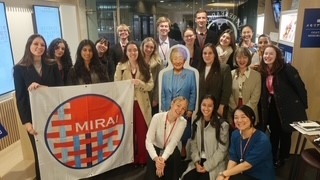Culture & Education
2025/11/13
MIRAI Programme - Molly Carroll


On the 6 November I arrived in Tokyo with the rest of the group from MIRAI 2024 who were assigned the theme “Diplomacy and Security Policy.” We were first brought to visit the Ministry of Foreign Affairs where we all introduced ourselves and we met with officials from the Ministry. There, I was warmly welcomed by Kobari Saiko-san from JICE Exchange. It was very exciting to meet people from many different European countries. We were given a briefing session to help us settle in, and then we listened to an insightful talk from members of the ministry, as they shared Japan’s groundbreaking plan for a “Free and Open Indo-Pacific” (FOIP). This really demonstrated for me Japan’s interest in leading the world to more peace and cooperation in a time when security concerns are paramount.
The next day, we took the metro for the first time and were brought to the Ministry of Defence. We attended a lecture on Japan’s “National Security and Defence Strategies” as well as its “Defence Buildup Program.” We learned about the possibility of threats from the land, sea, air, and cyberspace. Japan’s vision for peace and security was not something I had been exposed to before, and as a student of International Peace Studies, the lecture really gave me an insight into different conceptions of peace and stability.
Following our visit to the Ministry of Defence, we learned about the remarkable life and enduring legacy of Ogata Sadako, the High Commissioner for Refugees at the United Nations. We then had the opportunity to tour the Ogata Sadako Research Institute for Peace and Development, operated by the Japan International Cooperation Agency (JICA). The exhibition halls showcased her extensive achievements and her leadership as the institute’s former President. In 1991, Madam Sadako broke new ground by becoming the first woman to hold the position of High Commissioner for Refugees at the United Nations. Her dedication to supporting vulnerable populations, particularly those displaced both internally and across international borders, was truly inspiring. She managed numerous humanitarian emergency missions, playing a crucial role in developing and promoting the concept of human security. We later delved deeper into this topic during a lecture, learning about its importance within the framework of the Sustainable Development Goals. This experience provided a unique and valuable opportunity to broaden my understanding of the efforts made to safeguard and improve the lives of people facing insecurity and displacement. Moreover, engaging with my classmates and hearing about the specific challenges they face in their own countries gave me a more comprehensive view of the global issues surrounding insecurity and the ongoing efforts to address them.
The next day, we took the metro for the first time and were brought to the Ministry of Defence. We attended a lecture on Japan’s “National Security and Defence Strategies” as well as its “Defence Buildup Program.” We learned about the possibility of threats from the land, sea, air, and cyberspace. Japan’s vision for peace and security was not something I had been exposed to before, and as a student of International Peace Studies, the lecture really gave me an insight into different conceptions of peace and stability.
Following our visit to the Ministry of Defence, we learned about the remarkable life and enduring legacy of Ogata Sadako, the High Commissioner for Refugees at the United Nations. We then had the opportunity to tour the Ogata Sadako Research Institute for Peace and Development, operated by the Japan International Cooperation Agency (JICA). The exhibition halls showcased her extensive achievements and her leadership as the institute’s former President. In 1991, Madam Sadako broke new ground by becoming the first woman to hold the position of High Commissioner for Refugees at the United Nations. Her dedication to supporting vulnerable populations, particularly those displaced both internally and across international borders, was truly inspiring. She managed numerous humanitarian emergency missions, playing a crucial role in developing and promoting the concept of human security. We later delved deeper into this topic during a lecture, learning about its importance within the framework of the Sustainable Development Goals. This experience provided a unique and valuable opportunity to broaden my understanding of the efforts made to safeguard and improve the lives of people facing insecurity and displacement. Moreover, engaging with my classmates and hearing about the specific challenges they face in their own countries gave me a more comprehensive view of the global issues surrounding insecurity and the ongoing efforts to address them.

The following day we were brought to meet students in Keio University. This university is one of Japan’s most prestigious institutions. During our visit, we had the opportunity to attend lectures by Professor Hosoya Yuichi, who provided insights into Japan’s current diplomatic strategies, as well as Associate Professor Tsuruoka Michito, who discussed Japan’s latest security and defence challenges. Both lectures we attended highlighted the significance of the “Free and Open Indo-Pacific” Vision. This was a concept that had been mentioned to us on our first day, but we learned about in greater detail here. We discovered that the concept of FOIP was introduced at the Sixth Tokyo International Conference on African Development (TICAD VI) in Kenya, by Prime Minister Shinzo Abe in his keynote address.
Before leaving Keio University, we explored its picturesque campus and visited the Fukuzawa Yukichi Memorial Keio History Museum. The students we met there were friendly and welcoming, and they kindly invited us to join them for a tour of Tokyo Tower. During our visit, we went up to the Main Deck. It was a poetic moment to witness the sun setting over the Land of the Rising Sun during our brief stay.
Before leaving Keio University, we explored its picturesque campus and visited the Fukuzawa Yukichi Memorial Keio History Museum. The students we met there were friendly and welcoming, and they kindly invited us to join them for a tour of Tokyo Tower. During our visit, we went up to the Main Deck. It was a poetic moment to witness the sun setting over the Land of the Rising Sun during our brief stay.

On our fourth day, 9 November, we visited the Diplomatic Archives Exhibition Room. It functions as an archival institution dedicated to preserving and showcasing historical artifacts and diplomatic documents that commemorate key moments in Japan’s international relations. The Diplomatic Archives offer a dedicated permanent Exhibition Room that is open to visitors. In this space, guests can view a wide range of historically significant materials, including diplomatic correspondences, treaties, and various important documents that trace Japan’s diplomatic history from the late Tokugawa era all the way to contemporary times. Later that day, we travelled by metro to visit the National Diet Building. Using an English audio guide, we explored its remarkable architecture and gained insights into the Chamber of the House of Representatives, learning about its design and the significance of its governance.


Our final full day in Japan began with a visit to the Japan Ground Self-Defence Force (JGSDF) Public Information Centre in Asaka, Saitama. For me, the most interesting part was learning about their efforts on humanitarian missions and the ways in which they strive to improve their disaster responses in Japan and abroad. Lastly before we said our goodbyes, we had the opportunity to give a presentation of all what we had seen and learned from MIRAI. In just a week we had learned so much from MIRAI that we all found it difficult to keep our presentations brief. We presented to Mr. KAKIHARA Motoo, Director of the European Policy Division, and Mr. FUKAZAWA Yoichi, Parliamentary Vice-Minister for Foreign Affairs.

On 12 November, we each headed to our respective flights, bidding farewell after forming many new friendships with people from Europe and Japan. I am deeply grateful to MIRAI and JICE for giving me this incredible opportunity to meet such wonderful, kind individuals. Engaging with Japanese experts enriched my understanding by shedding light on the common challenges our countries face and offering practical strategies to address them. Each speaker broadened my perspective and strengthened my motivation to contribute to the shared goal of peace.
